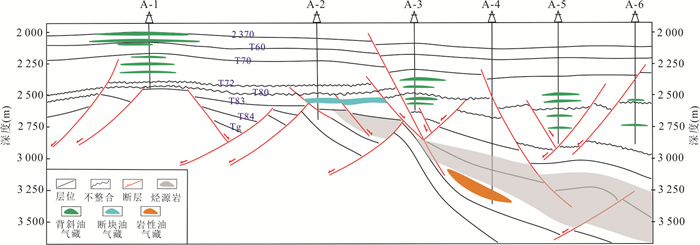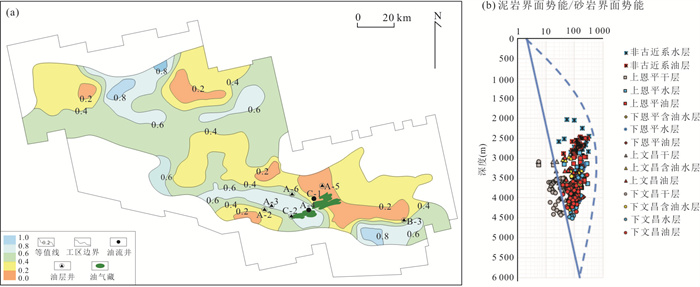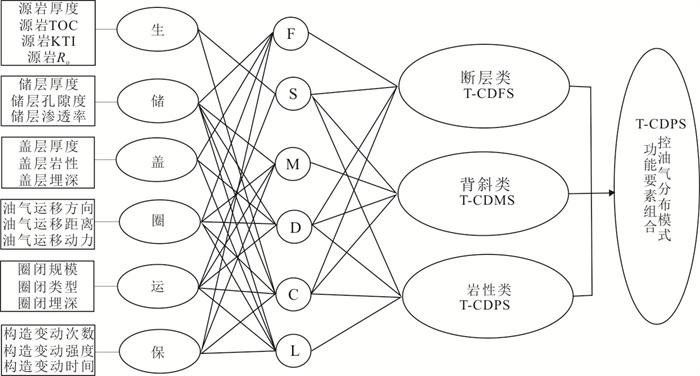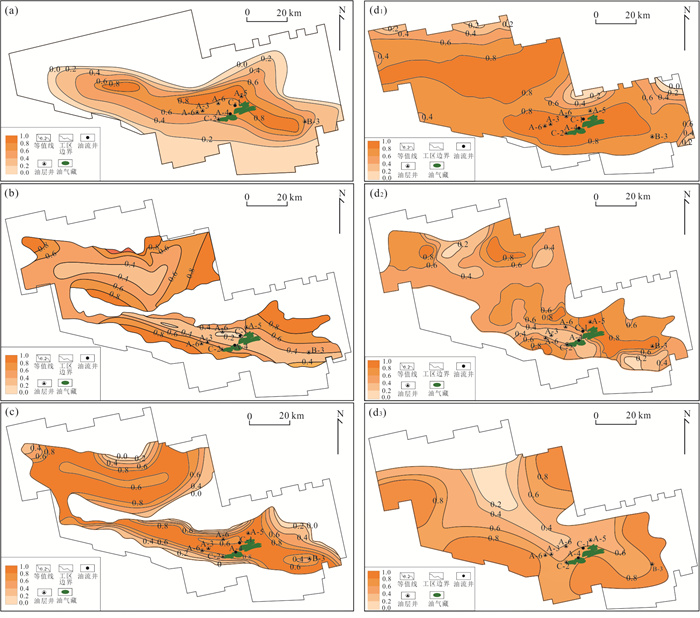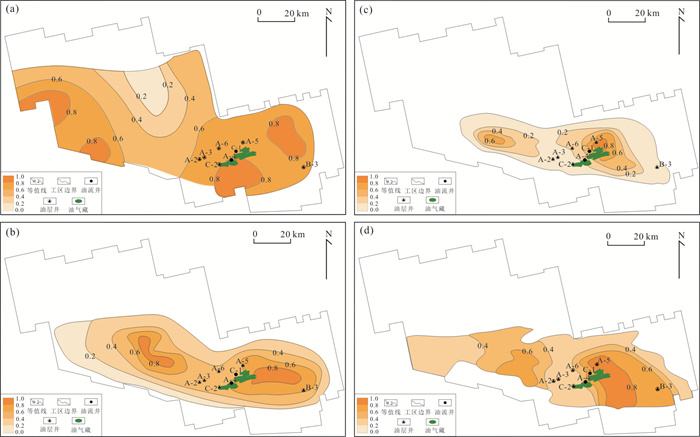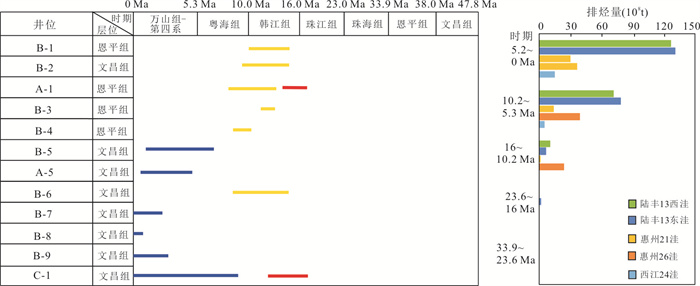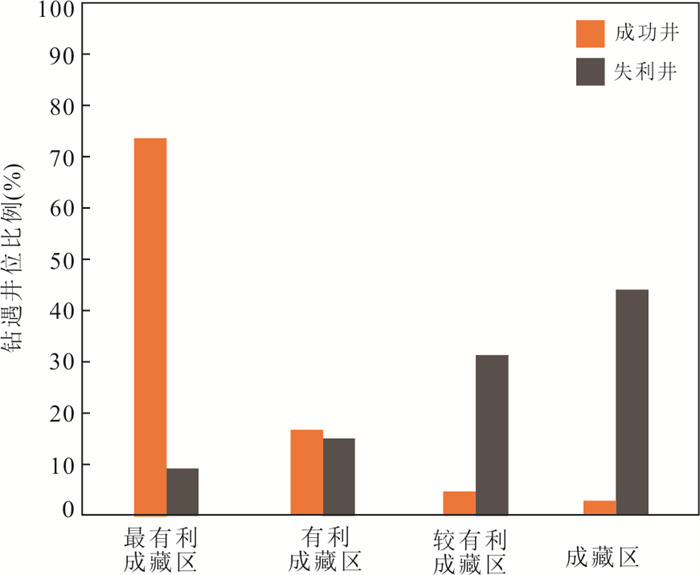Quantitative Prediction and Evaluation of Paleogene Favorable Hydrocarbon Accumulation Areas with Multi-Dynamic-Stage-Factor Combination in Lufeng Sag, Pearl River Mouth Basin
-
摘要: 珠江口盆地陆丰凹陷古近系油气成藏受多种动力多种要素联合控制,因此不能完全依照经典的浮力成藏理论预测有利成藏区带. 通过剖析研究区已经发现的油气藏揭示出三种动力对油气成藏起到了关键作用,包括低位能(背斜类油气藏)、低压能(断块类油气藏)、低界面能(岩性地层类油气藏);在每一种动力作用下,油气成藏受到有效烃源层、优相储层、区域盖层、低势区带4个功能要素及其时空组合的控制. 通过建立多动力‒多要素复合成藏模式,对陆丰凹陷古近系4个目的层有利成藏区带进行了预测评价,优选出10个最有利目标,为研究区油气深化勘探和钻探目标优选提供了科学依据.Abstract: The Paleogene oil and gas accumulation in Lufeng Sag of the Pearl River Mouth Basin is jointly controlled by a variety of dynamic factors, so the favorable reservoir forming area can not be predicted completely according to the classical buoyancy reservoir forming theory. By analyzing the discovered oil and gas reservoirs in the study area, in this paper it reveals that three driving forces play a key role in oil and gas accumulation, including low-level energy (anticline oil and gas reservoir), low-pressure energy (fault block oil and gas reservoir) and low interface energy (lithologic stratigraphic oil and gas reservoir). Under each dynamic action, oil and gas accumulation is controlled by four functional elements and their temporal and spatial combination: effective source rock, excellent facies reservoir, regional cap rock and low potential zone. By establishing a multi⁃dynamic⁃factor composite reservoir forming model, the favorable reservoir forming zones of four target layers in Lufeng Sag are predicted and evaluated, and 10 most favorable targets are selected, which provides a scientific basis for deepening oil and gas exploration and optimizing drilling targets in the study area.
-
图 10 陆丰凹陷多要素和多动力分别控油气成藏分布预测评价结果
a.上恩平组源控油气成藏概率平面分布图;b.上恩平组相控油气成藏概率平面分布图;c.上恩平组盖控油气成藏概率平面分布图;d1.上恩平组断裂带低压能控油气成概率平面分布图;d2.上恩平组砂岩体毛细管力差低界面能控油气成藏概率平面分布图;d3.上恩平组古隆起低位能控概率平面分布图
Fig. 10. Prediction and evaluation results of reservoir formation and distribution controlled by multi⁃factor and multi⁃dynamic in Lufeng Sag
表 1 部分探井功能要素成藏概率
Table 1. Reservoir forming probability of functional elements of some exploration wells
井号 层位 各要素成藏概率 C
(区域盖层)D
(沉积相)L、M、F
(低势区)S
(烃源灶)D-1 上文昌 0.8 0.3 0.1 0.95 D-2 上文昌 0.9 0.5 0.35 0.7 D-3 上文昌 0.1 / / 0.65 D-4 上文昌 0.1 / / 0.6 D-5 上文昌 0.1 / 0.1 0.7 D-6 上文昌 0.75 0.4 0.3 0.85 D-7 上文昌 0.27 0.8 0.2 0.4 D-8 上文昌 0.3 0.85 0.2 0.65 D-9 下文昌 0.3 0.4 0.1 0.85 A-6 下文昌 0.4 0.3 0.3 0.8 E-1 下文昌 0.4 0.3 0.45 0.7 E-2 下文昌 0.65 0.3 / / E-3 下文昌 0.4 0.2 0.3 0.85 E-4 下文昌 0.2 0.5 / 0.7 E-5 下文昌 / / / 0.7 E-6 下文昌 0.6 0.3 0.55 0.95 E-7 下文昌 0.2 0.5 0.2 0.7 E-8 下文昌 0.4 0.3 0.45 0.8 E-9 下文昌 0.4 0.4 0.3 0.8 F-1 下文昌 0.7 0.3 0.55 0.95 F-2 下文昌 0.5 0.2 0.45 0.82 F-3 下文昌 0.4 0.3 0.55 0.85 F-4 下文昌 0.2 0.6 0.1 0.7 A-2 下文昌 0.3 0.5 0.1 0.85 F-5 下文昌 0.3 0.5 0.45 0.85 F-6 下文昌 0.2 0.5 0.35 0.6 F-7 下文昌 0.2 0.5 0.2 0.65 A-5 下文昌 0.4 0.4 0.4 0.7 A-4-1 下文昌 0.3 0.37 0.3 0.9 A-4-2 下文昌 0.3 0.37 0.3 0.9 F-8 下文昌 0.6 0.3 0.6 0.9 -
Beglinger, S. E., Doust, H., Cloetingh, S., 2012. Relating Petroleum System and Play Development to Basin Evolution: West African South Atlantic Basins. Marine and Petroleum Geology, 30(1): 1-25. https://doi.org/10.1016/j.marpetgeo.2011.08.008 Cheng, Y. J., Wu, Z. P., Zhang, J., et al., 2020. Early Cenozoic Evolution of Fault System in Xijiang Sag and Its Implication to Clockwise Rotation of Extension Stress in Northern Margin of South China Sea. Earth Science, 45(6): 2199-2209 (in Chinese with English abstract). Dai, J. X., Song, Y., Zhang, H. F., 1996. The Main Controlling Factors for the Formation of Large and Medium⁃Sized Gas Fields in China. Scientia Sinica Terrae, 26(6): 481-487 (in Chinese). Dai, Y. D., Niu, Z. C., Wang, X. D., et al., 2019. Difference of Oil and Gas Enrichment Law between Paleogene and Neogene in Lufeng Sag of Pearl River Mouth Basin and Its Main Controlling Factors. Journal of Petroleum, 40 (Supplement 1): 41-52. Davis, R. W., 1987. Analysis of Hydrodynamic Factors in Petroleum Migration and Entrapment. AAPG Bulletin, 71(6): 643-649. https://doi.org/10.1306/94887884⁃1704⁃11d7⁃8645000102c1865d Downey, M. W., 1984. Evaluating Seals for Hydrocarbon Accumulations. AAPG Bulletin, 68(11): 1752-1763. https://doi.org/10.1306/ad461994⁃16f7⁃11d7⁃8645000102c1865d England, W. A., MacKenzie, A. S., Mann, D. M., et al., 1987. The Movement and Entrapment of Petroleum Fluids in the Subsurface. Journal of the Geological Society, 144(2): 327-347. https://doi.org/10.1144/gsjgs.144.2.0327 Evamy, B. D., Haremboure, J., Kamerling, P., et al., 1978. Hydrocarbon Habitat of Tertiary Niger Delta. AAPG Bulletin, 62(1): 1-39. https://doi.org/10.1306/c1ea47ed⁃16c9⁃11d7⁃8645000102c1865d Grunau, H. R., 1987. A Worldwide Look at the Cap⁃Rock Problem. Journal of Petroleum Geology, 10(3): 245-265. https://doi.org/10.1111/j.1747⁃5457.1987.tb00945.x He, M., Graham, S., Scheirer, A. H., et al., 2014. A Basin Modeling and Organic Geochemistry Study in the Vallecitos Syncline, San Joaquin Basin, California. Marine and Petroleum Geology, 49: 15-34. https://doi.org/10.1016/j.marpetgeo.2013.09.001 Hu, C. Y., 2005. Research on the Appliance Extent of "Source Control Theory" by Semi⁃Quantitative Statistics Characteristics of Oil and Gas Migration Distance. Natural Gas Industry, 25(10): 1-3 (in Chinese with English abstract). Hu, J. Y., Xu, S. B., Tong, X. G., 1986. Formation and Distribution of Complex Petroleum Accumulation Zones in Bohaiwan Basin. Petroleum Expoloration and Development, 13(1): 1-8 (in Chinese with English abstract). Hubbert, M. K., 1953. Entrapment of Petroleum under Hydrodynamic Conditions. AAPG Bulletin, 37(8): 1954-2026. https://doi.org/10.1306/5ceadd61⁃16bb⁃11d7⁃8645000102c1865d Jiang, Z. X., Yang, H. J., Li, Z., et al., 2010. Differences of Hydrocarbon Enrichment between the Upper and the Lower Structural Layers in the Tazhong Paleouplift. Acta Geologica Sinica (English Edition), 84(5): 1116-1127. https://doi.org/10.1111/j.1755⁃6724.2010.00284.x Klemme, H. D., Ulmishek, G. F., 1991. Effective Petroleum Source Rocks of the World: Stratigraphic Distribution and Controlling Depositional Factors. AAPG Bulletin, 75(12): 1809-1851. https://doi.org/10.1306/0c9b2a47⁃1710⁃11d7⁃8645000102c1865d Li, J. H., 2012. Oil and Gas Distribution Model Controlled by Functional Element Combination and Its Application in Damintun Sag (Dissertation). China University of Petroleum, Beijing (in Chinese with English abstract). Magoon, L. B., Dow, W. G., 1994. The Petroleum System: From Source to Trap. AAPG Memoir 60. AAPG, Tulsa. Meng, Q. Y., Pang, X. Q., Gao, J. B., 2008. The Multi⁃Factor Recombination and Processes Superimposition Model for Hydrocarbon Accumulation: Application to the Silurian in the Tarim Basin. Petroleum Science, 5(1): 13-19. https://doi.org/10.1007/s12182⁃008⁃0002⁃8 Mi, L. J., Zhang, X. T., Chen, W. T., et al., 2018. Hydrocarbon Enrichment Law of Paleogene Zhu1 Depression and Its next Exploration Strategy in Pearl River Mouth Basin. China Offshore Oil and Gas, 30(6): 1-13 (in Chinese with English abstract). Pang, H., Chen, J. Q., Pang, X. Q., et al., 2013. Key Factors Controlling Hydrocarbon Accumulations in Ordovician Carbonate Reservoirs in the Tazhong Area, Tarim Basin, Western China. Marine and Petroleum Geology, 43: 88-101. https://doi.org/10.1016/j.marpetgeo.2013.03.002 Pang, X. Q., 1995. Theory and Application of Hydrocarbon Expulsion Threshold Oil and Gas Control. Petroleum Industry Press, Beijing (in Chinese). Pang, X. Q., Jia, C. Z., Chen, J. Q., et al., 2021a. A Unified Model for the Formation and Distribution of Both Conventional and Unconventional Hydrocarbon Reservoirs. Geoscience Frontiers, 12(2): 695-711. https://doi.org/10.1016/j.gsf.2020.06.009 Pang, X. Q., Jia, C. Z., Wang, W. Y., et al., 2021b. Buoyance⁃Driven Hydrocarbon Accumulation Depth and Its Implication for Unconventional Resource Prediction. Geoscience Frontiers, 12(4): 101133. https://doi.org/10.1016/j.gsf.2020.11.019 Pang, X. Q., Shao, X. H., Li, M. W., et al., 2021c. Correlation and Difference between Conventional and Unconventional Reservoirs and Their Unified Genetic Classification. Gondwana Research, 97: 73-100. https://doi.org/10.1016/j.gr.2021.04.011 Pang, X. Q., Jin, Z. J., Jiang, Z. X., et al., 2002. Evaluation of Hydrocarbon Resources of Superimposed Basin and Its Significance. Petroleum Exploration and Development, 29(1): 9-13 (in Chinese with English abstract). Pang, X. Q., Luo, X. R., Jiang, Z. X., et al., 2007. Advancements and Problems on Hydrocarbon Accumulation Research of Complicated Superimposed Basins in Western China. Advances in Earth Science, 22(9): 879-887 (in Chinese with English abstract). Pang, X. Q., Zhou, X. Y., Jiang, Z. X., et al., 2012. Hydrocarbon Reservoirs Formation, Evolution, Prediction and Evaluation in the Superimposed Basins. Acta Geologica Sinica, 86(1): 1-103 (in Chinese with English abstract). doi: 10.1111/j.1755-6724.2012.00606.x Pedersen, T. F., Calvert, S. E., 1990. Anoxia vs. Productivity: What Controls the Formation of Organic⁃Carbon⁃Rich Sediments and Sedimentary Rocks? AAPG Bulletin, 74(4): 454-466. https://doi.org/10.1306/0c9b232b⁃1710⁃11d7⁃8645000102c1865d Perrodon, A., 1992. Petroleum Systems: Models and Applications. Journal of Petroleum Geology, 15(2): 319-325. https://doi.org/10.1111/j.1747⁃5457.1992.tb00875.x Reading, H. G., 1978. Sedimentary Environments and Facies. Palaios, 1(5): 517-518. https://doi.org/10.1017/S0016756800044113 Sun, Q. L., Wu, S. G., Lü, F. L., et al., 2010. Polygonal Faults and Their Implications for Hydrocarbon Reservoirs in the Southern Qiongdongnan Basin, South China Sea. Journal of Asian Earth Sciences, 39(5): 470-479. https://doi.org/10.1016/j.jseaes.2010.04.002 Tissot, B. P., Welte, D. H., 1978. Petroleum Formation and Occurrence. Springer⁃Verlag, Berlin. Wang, H. J., Pang, X. Q., Wang, Z. M., et al., 2010. Multiple⁃Element Matching Reservoir Formation and Quantitative Prediction of Favorable Areas in Superimposed Basins. Acta Geologica Sinica (English Edition), 84(5): 1035-1054. https://doi.org/10.1111/j.1755⁃6724.2010.00280.x Zhang, Q. Q., Liu, K. Y., Heng, L. Q., et al., 2021. Characteristics and Genetic Distribution Model of Top Calcareous Cementation Layers within Zhujiang Formation in Panyu a Oilfield, Pearl River Mouth Basin. Earth Science, 46(5): 1783-1796 (in Chinese with English abstract). Zhang, S. C., Huang, H. P., 2005. Geochemistry of Palaeozoic Marine Petroleum from the Tarim Basin, NW China: Part 1. Oil Family Classification. Organic Geochemistry, 36(8): 1204-1214. https://doi.org/10.1016/j.orggeochem.2005.01.013 Zhang, S. C., Zhang, B. M., Li, B. L., et al., 2011. History of Hydrocarbon Accumulations Spanning Important Tectonic Phases in Marine Sedimentary Basins of China: Taking the Tarim Basin as an Example. Petroleum Exploration and Development, 38(1): 1-15. https://doi.org/10.1016/S1876⁃3804(11)60010⁃4 Zhou, X. X., 1997. Essentials about Hydrocarbon Distribution Controlled by Source and Sela. Petroleum Exploration and Development, 24(6): 4-7 (in Chinese with English abstract). Zhu, X. M., 2008. Sedimentary Petrology. Petroleum Industry Press, Beijing (in Chinese). 程燕君, 吴智平, 张杰, 等, 2020. 西江凹陷早新生代断裂演化及其对南海北缘应力场顺时针旋转的响应. 地球科学, 45(6): 2199-2209. doi: 10.3799/dqkx.2019.250 戴金星, 宋岩, 张厚福, 1996. 中国大中型气田形成的主要控制因素. 中国科学: 地球科学, 26(6): 481-487. doi: 10.3321/j.issn:1006-9267.1996.06.001 胡朝元, 2005. "源控论"适用范围量化分析. 天然气工业, 25(10): 1-3. doi: 10.3321/j.issn:1000-0976.2005.10.001 胡见义, 徐树宝, 童晓光, 1986. 渤海湾盆地复式油气聚集区(带)的形成和分布. 石油勘探与开发, 13(1): 1-8. https://www.cnki.com.cn/Article/CJFDTOTAL-SKYK198601000.htm 李建华, 2012. 功能要素组合控油气分布模式及其在大民屯凹陷的应用(博士学位论文). 北京: 中国石油大学. 米立军, 张向涛, 陈维涛, 等, 2018. 珠江口盆地珠一坳陷古近系油气富集规律及下一步勘探策略. 中国海上油气, 30(6): 1-13. https://www.cnki.com.cn/Article/CJFDTOTAL-ZHSD201806001.htm 庞雄奇, 1995. 排烃门限控油气理论与应用. 北京: 石油工业出版社. 庞雄奇, 金之钧, 姜振学, 等, 2002. 叠合盆地油气资源评价问题及其研究意义. 石油勘探与开发, 29(1): 9-13. doi: 10.3321/j.issn:1000-0747.2002.01.003 庞雄奇, 罗晓容, 姜振学, 等, 2007. 中国西部复杂叠合盆地油气成藏研究进展与问题. 地球科学进展, 22(9): 879-887. doi: 10.3321/j.issn:1001-8166.2007.09.001 庞雄奇, 周新源, 姜振学, 等, 2012. 叠合盆地油气藏形成、演化与预测评价. 地质学报, 86(1): 1-103. https://www.cnki.com.cn/Article/CJFDTOTAL-DZXE201201003.htm 张青青, 刘可禹, 衡立群, 等, 2021. 珠江口盆地番禺A油田珠江组"顶钙"发育特征、成因与分布模式. 地球科学, 46(5): 1783-1796. doi: 10.3799/dqkx.2020.139 周兴熙, 1997. 源‒盖共控论述要. 石油勘探与开发, 24(6): 4-7. https://www.cnki.com.cn/Article/CJFDTOTAL-SKYK199706001.htm 朱筱敏, 2008. 沉积岩石学. 北京: 石油工业出版社. -









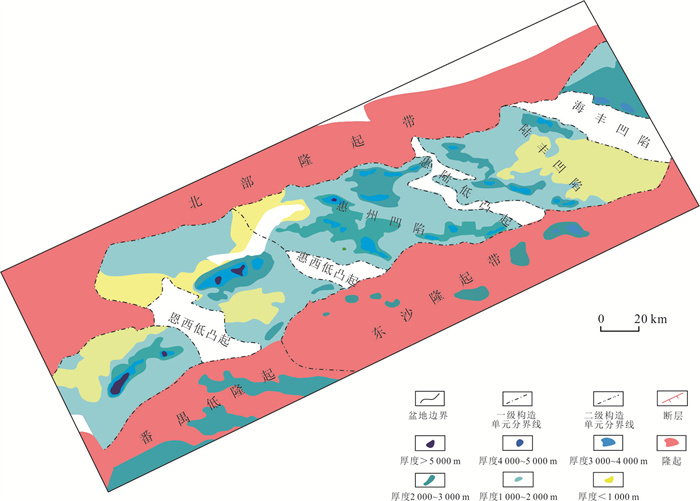
 下载:
下载:
